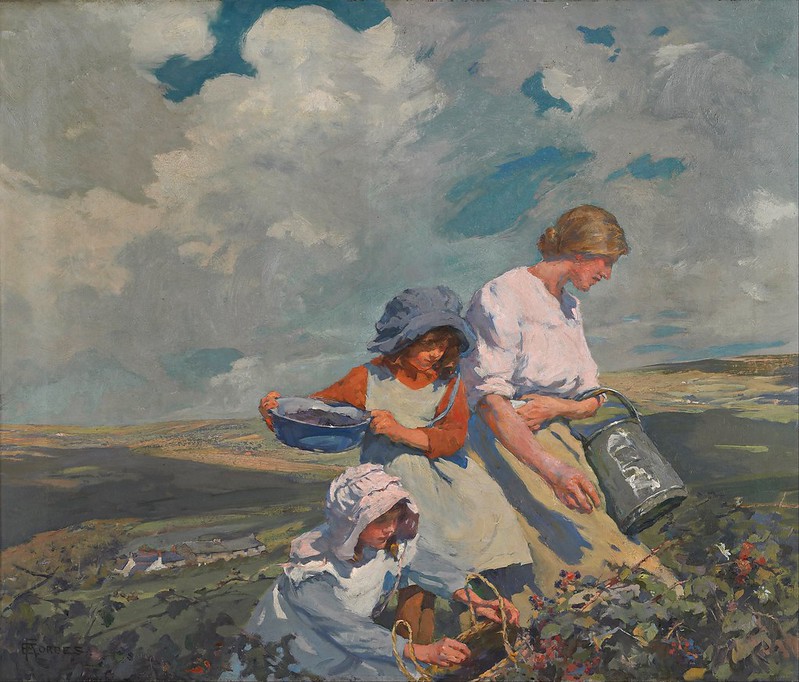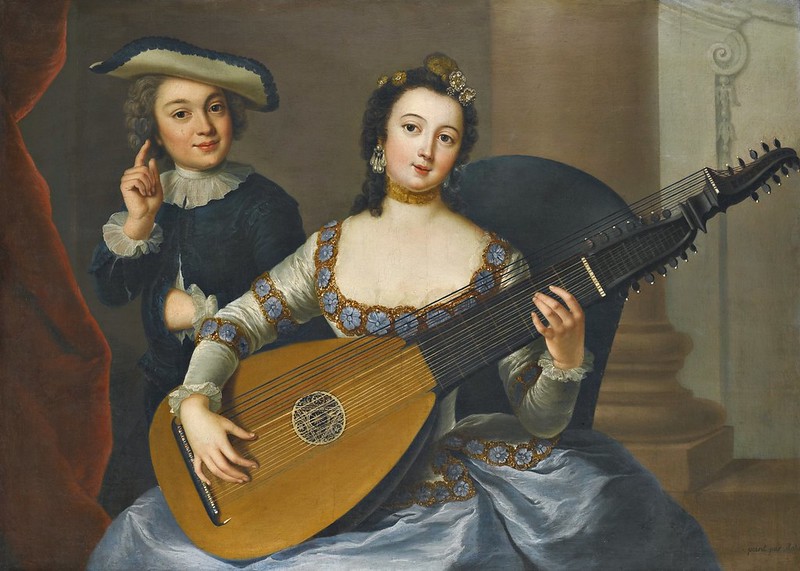Obra d'Elizabeth Adela Armstrong (1859-1912), pintora canadenca (1)
- Recordatori d'Ernst Rudorff -
En el dia de la commemoració del seu 100è aniversari de decés
Parlem de Pintura...
Elizabeth Adela Armstrong (Kingston, 29 de desembre de 1859 - Newlyn, 16 de març de 1912) va ser una pintora canadenca. De petita es va traslladar amb la seva família a Anglaterra, on es va formar a partir dels 14 anys a l'escola d'art de Kensington i a on va rebre la influència dels pintors pre-rafaelites. El 1878 va entrar a la Lliga d'Estudiants d'Art de Nova York on va estudiar amb William Merritt Chase. Al finalitzar els seus estudis el 1881, va viatjar amb la seva família a Munich, on va conèixer a la pintora Marianne Preindlsberger, i després a Pont Aven on va rebre formació en gravat. El 1884 va viatjar a Holanda i va començar a exhibir les seves obres, moltes d'elles a Londres. Després del seu matrimoni amb Stanhope Forbes, va disminuir el seu treball com a pintora si bé no el va abandonar. El 1889 va rebre una medalla a París, el 1893 a Chicago i el 1910 una condecoració a la Royal British Colonial Society. Després del seu matrimoni va viure a Newlyn, on va formar part de la Newlyn School i on va morir el març de 1912.
Font: En català: No disponible - En castellano: No disponible - In english: Elizabeth Adela Armstrong (1859-1912) - Altres: Elizabeth Adela Armstrong (1859-1912)
Parlem de Música...
Ernst Rudorff (Berlin, 18 de gener de 1840 - Berlin, 31 de desembre de 1916) va ser un director, pianista, professor i compositor alemany. De família benestant i de profunds inquietuds culturals, la seva mare Betty Pistor (1808-1887) va ser amiga d'infància de Mendelssohn i alumne de Zelter, i el seu pare va ser professor de dret a Berlín i alumne de Friedrich Carl von Savigny. Rudorff es va formar en piano i composició amb Woldemar Bargiel, violí amb Louis Ries i posteriorment piano amb Clara Schumann, amb qui també va compartir amistat. A partir del 1859 va estudiar teologia i història a les universitats de Berlin i Leipzig. En aquesta ciutat va entrar al Conservatori on va estudiar piano amb Moscheles i composició amb Julius Rietz. Paral·lelament, va rebre classes privades de Reinecke i Hauptmann. La seva primera feina va ser la de director i assistent de Julius Stockhausen a Hamburg abans d'entrar com a professor del Conservatori de Köln, on va fundar la Bach Society el 1867. A partir del 1869 va esdevenir professor de la Berlin Hochschule für Musik. A Berlín va succeir, també, a Bruch com a director de la Stern Choral Society. Va morir a Berlin el desembre de 1916.
OBRA:
Vocal:
Songs, duets and choral works, incl. Aufzug der Romanze (Tieck), solo vv, chorus, orch, op.18;
2 Gesänge, S, female vv, orch, op.19;
Gesang an die Sterne (Rückert), 6vv, orch, op.26;
Herbstlied, 6vv, orch, op.43;
Ave Maria am Rhein, S, female vv, orch unpubd;
10 songs, female vv, pf, unpubd;
4 songs, v, pf, unpubd
Instrumental:
Orch and chbr:
3 syms.: opp.31, 40, 50;
3 ovs.: Der blonde Ekbert, op.8, Otto der Schütz, op.12, Romantische Ouvertüre, op.45;
2 serenades, opp.20, 21;
Variations on an Original Theme, op.24;
Ballade, Introduction, Scherzo and Finale, op. 15;
Romance, vn, orch, op.41;
Romance, vc, orch, op.7;
Sextet, 3 vn, va, 2 vc, op.5;
Intermezzo, orch, unpubd
Pf 4 hands:
Variations, 2 pf, op.1;
Klavierstücke op.4;
Kinderwalzer op.38;
Klavierstücke op.54
Pf solo:
Fantasiestücke, op.10;
Fantasie, op.14;
2 Konzertetüden, op.29;
3 Romanzen, op.48;
Capriccio appassionato, op.49;
Impromptu, op.51;
Klavierstücke, op.52;
Variazioni capricciose, op. 55;
2 Balladen, unpubd
Font: En català: No disponible - En castellano: No disponible - In english: Ernst Rudorff (1840-1916) - Altres: Ernst Rudorff (1840-1916)OBRA:
Vocal:
Songs, duets and choral works, incl. Aufzug der Romanze (Tieck), solo vv, chorus, orch, op.18;
2 Gesänge, S, female vv, orch, op.19;
Gesang an die Sterne (Rückert), 6vv, orch, op.26;
Herbstlied, 6vv, orch, op.43;
Ave Maria am Rhein, S, female vv, orch unpubd;
10 songs, female vv, pf, unpubd;
4 songs, v, pf, unpubd
Instrumental:
Orch and chbr:
3 syms.: opp.31, 40, 50;
3 ovs.: Der blonde Ekbert, op.8, Otto der Schütz, op.12, Romantische Ouvertüre, op.45;
2 serenades, opp.20, 21;
Variations on an Original Theme, op.24;
Ballade, Introduction, Scherzo and Finale, op. 15;
Romance, vn, orch, op.41;
Romance, vc, orch, op.7;
Sextet, 3 vn, va, 2 vc, op.5;
Intermezzo, orch, unpubd
Pf 4 hands:
Variations, 2 pf, op.1;
Klavierstücke op.4;
Kinderwalzer op.38;
Klavierstücke op.54
Pf solo:
Fantasiestücke, op.10;
Fantasie, op.14;
2 Konzertetüden, op.29;
3 Romanzen, op.48;
Capriccio appassionato, op.49;
Impromptu, op.51;
Klavierstücke, op.52;
Variazioni capricciose, op. 55;
2 Balladen, unpubd
Parlem en veu pròpia o en veu d'altri...
Rudorff is neither the first nor the last composer to be stuck in an artistic time-warp. The Third Symphony recorded here was first performed - by the Berlin Philharmonic - in 1911 but in all regards it could easily have been composed fifty years earlier. The main note I made was Rudorff's fascination for switching between compound time - 6/8 - the quaver or eighth notes 2 groups of 3 and then 3 groups of 2. Its a very common hemiola effect found in music for centuries. In 1911 - the year of Petrushka - it does not seem so revolutionary. To me that would not matter in the slightest if the rest of the material; melodically or harmonically was memorable. Sadly, this steadfastly is not. Reinecke, Rudorff's teacher, writing in his memoir singled him out as more significant a musician than his other pupils; Grieg or Sullivan. Perhaps that says more about Reinecke's expectations and musical standards than it does anything else. Certainly, Rudorff would benefit hugely from even a fraction of the melodic ability of either of those two composers. The Symphony is in four movements with the slow movement - a funeral march - second. The opening Allegro con brio has the aforementioned rhythmic shift that does create initial interest even with its Schumannesque echoes but he uses it so frequently in the movement that it soon palls. Just to be clear, this is by no means bad but with so much music to discover or delve deeper into I find it hard to justify spending too much time on the modest achievement that this is. Even the orchestration itself is remarkably conservative - again nothing a mid-19th Century composer would have raised their eyebrows at. The second movement 'in modo di marcia funebre' is more interesting - all the more so for avoiding just being a foursquare slow march.
However, consider that another essentially conservative work - Elgar's Symphony No.2 was completed just over two weeks after this work's premiere and also contains a funeral march of infinitely greater emotional range, melodic power and orchestrational genius. Again this Rudorff Symphony falls by the wayside. The third movement 'quasi Andantino' again features shifting meter combined with the gentle lyricism much in the spirit of a Brahms Serenade. This contrasts with a dynamic central section which clams and blends back seamlessly to the opening lyrical melody. In many ways this is the most wholly successful movement in the work. The closing Allegro giocoso has to try too hard to bring proceedings to a satisfactory close. There is motivic relationship between sections but unfortunately the sense is of them being academically worked out rather than returning in an emotionally satisfying manner. There is a ghastly passage towards the end with bass drum and cymbals marking every quick-march beat - thankfully brief. Much the same criticism can be levelled at the Orchestral Variations which predate the Symphony by a full 35 years. The best variations it seems to me, take an often simple theme and then find depths and character in it that reflect more on the composer than the theme itself - which after all is little more than a point of initiation. Here Rudorff goes through the prescribed full range of variation form with varied tempo, metre, orchestral colour and emotion but it feels like more of an exercise than compelling exploration of thematic potential.
Again, nothing that could be termed 'wrong' or 'bad' but so many other similar works spring to mind that are infinitely 'better'. Interestingly, the liner quotes a letter to the composer from Brahms who mentions these Variations. Certainly, the influence of Brahms more than Schumann is clearly apparent. Both works are well crafted in terms of scale and thoroughly competent. The score of the Symphony can be followed on IMSLP and on the page the orchestration looks clean and sensible but to the eye as to the ear - nothing surprises.Again true to CPO form, the orchestra used here is a lesser known German ensemble, the Bochumer Symphoniker. Both their playing and the engineering are reliably good - there are so few poor orchestral recordings these days. That being said, the Bochum strings just occasionally lack the last degree of unanimity that another take or extra session might have ensured. Much as with the music, nothing bad enough to get upset by but not out of the topmost drawer. Likewise with the interpretation, with no comparable version it is very hard to judge conductor Frank Beermann's contribution. My instinct is that there is not much more he could have done with the works - certainly the playing has energy and commitment, there is a good wide dynamic range and the woodwind solos are attractively played. Something about a purse and a sow's ear springs to mind.I often say that CPO are one of my favourite labels and many of their enterprising releases have entertained and informed me hugely. This one might just stay in a bottom drawer gathering dust.
Nick Barnard (source/font: aquí)
Gaudiu i compartiu!
Informació addicional...
JPC: RUDORFF, E. - Symphony No. 3, Op. 50 & Variations Op. 24
IMSLP: Ernst Rudorff (1840-1916)
SPOTIFY: RUDORFF, E. - Symphony No. 3, Op. 50 & Variations Op. 24

Tant si us ha agradat, com si no, opineu, és lliure i fàcil!

Tant si us ha agradat, com si no, opineu, és lliure i fàcil!






